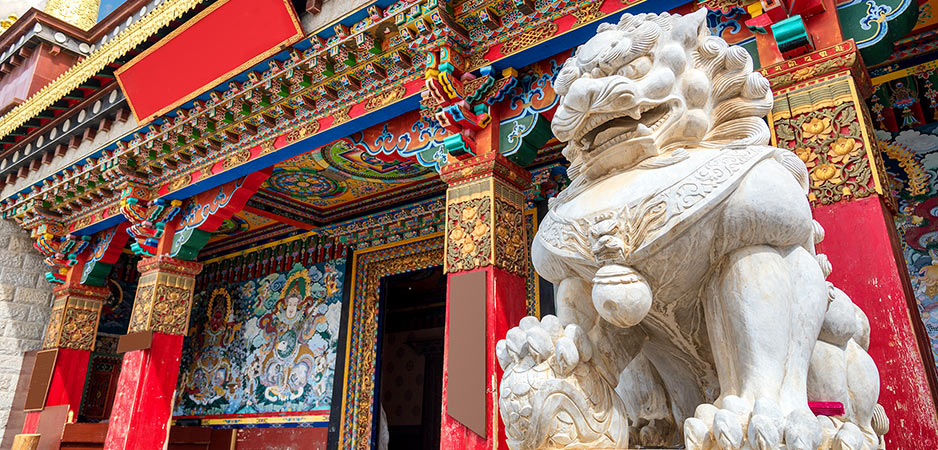Wildfires have been burning in California, Brazil and Siberia. Brexit is causing unending headaches in both Europe and the UK. The American election campaign has kicked off in high gear. Deaths from COVID-19 have crossed one million. US President Donald Trump’s taxes were the talk of the town, before he landed in hospital with COVID-19 himself. In such a milieu, it is easy to overlook a tempest in Asia. On October 5, China threatened to make India’s latest strategic tunnel unserviceable even as Indian engineers race against time and tough conditions to bolster their country’s border infrastructure.
Han and Hindu Nationalism Come Face to Face
For the last few months, India and China have been clashing over icy heights on the roof of the world. Their undefined border and contesting claims are causing increasing unease in the world’s largest and most populous continent. They are also leading to new moves on the geopolitical chessboard that might have historic consequences.
Tibetan Troops, Article 370 and Ladakh
Tenzin Nyima, a company leader in India’s shadowy Special Frontier Force (SFF) and a stateless Tibetan refugee, died on the contested Line of Actual Control that separates territories controlled by India and China. Hundreds of thousands of Tibetan refugees have lived in India since the Dalai Lama’s flight to the country in 1959. A select few serve in the SFF, an extremely tough outfit that excels in high-altitude operations.
The Tibetan Kashag was the de facto independent government of Tibet before the invasion by China’s People’s Liberation Army (PLA) in 1950, which was condemned by the United Nations General Assembly. The SFF fights under the snow lion flag of the Tibetan Kashag. The Central Tibetan Administration, known as the Tibetan Government in Exile, also uses the same flag. Understandably, the PLA, the Communist Party of China (CCP) and Chinese nationalists are not too fond of this symbol.
Nyima’s funeral in Ladakh occurred with much honor. Importantly, Ram Madhav, then the general secretary of India’s ruling Bharatiya Janata Party (BJP), was present at the funeral. His admirers refer to him as the “Kissinger of India.” More pertinently, Madhav is one of the most influential political figures in India and a key ideologue on strategic matters. He was a key architect of the BJP’s Kashmir policy and was instrumental in removing Article 370 last year, which ended Jammu and Kashmir’s autonomy. By honoring Nyima, Madhav is making a symbolic but profound point: He is signaling support for the Tibetan cause.
As most Indians and India hands know, the BJP had been vowing to remove Article 370 for decades. Once Prime Minister Narendra Modi won historic reelection last year, the BJP made a bold bet and removed this article from the constitution. It carved out Ladakh from the state of Jammu and Kashmir as a separate union territory. The people of this land practice Tibetan Buddhism, share ethnic kinship with Tibetans and follow the Dalai Lama. By removing Article 370 and giving Ladakhis their own territory, India has upset not only Pakistan but also China.
Salami Tactics
Historically, India’s stand on Tibet has been ineffectual. Despite domestic opposition, Jawaharlal Nehru acquiesced to the Chinese conquest of Tibet. Even after the disastrous defeat of 1962, India’s first prime minister did not come down on the side of the Tibetans. The Dalai Lama has lived in India for decades, but Delhi has never openly supported Tibetan independence or autonomy. In contrast, China has allied with Pakistan and opposed India’s interests in Jammu, Kashmir and Ladakh.
Since Modi came to power in 2014, he has met Chinese President Xi Jinping 18 times. He has been conciliatory and accommodating to Xi. Even before Modi, India opened its markets to Chinese products. This economic engagement was for a strategic reason: India wanted peace with its larger neighbor and aimed to wean it away from Pakistan. Instead, China has consistently followed salami tactics, and, this year, it cut off a larger slice of Indian territory.
Chinese actions led to Modi losing face earlier this year. The Indian National Congress (INC) party tried to paint him as the new Nehru. For the Nehru dynasty that still leads the INC, a debacle for Modi would wash off Nehru’s sins and damage the BJP. In the brutal battle for national dominance, an embarrassment for Modi would boost the INC. Hence, it is no surprise that Modi and Madhav are pushing back so strongly against China.
In recent years, India has been preparing for a two-front war. In 2018, India’s Air Force conducted its largest exercise to counter a joint China-Pakistan invasion. The junior minister in charge of border roads is General V.K. Singh, the former army chief. More than most, he understands the key need for border infrastructure and has been pushing hard for it. This has caused the Chinese grief because Indian infrastructure upgradation of its Central Asian tracts chips away at the PLA’s strategic advantage.
Public Sympathy
In recent weeks, Modi has gained public sympathy. The Indian public blames Xi for backstabbing him and the Indian intelligentsia for being too naive, if not deluded, about China. This public support has allowed Modi to take a stronger stance against Beijing. The PLA and Xi have been caught off guard. At high altitudes, Chinese troops have been weighed, measured and found wanting. Indian troops have not rolled over as in 1962. In fact, they have given the PLA a bloody nose. This is deeply embarrassing for a country with superpower pretensions. China is setting itself up as a counterpart to the US. Anything short of a conclusive victory against a country China deems to be its inferior would be nothing short of a national disaster.
As two of the authors explained in a historical analysis of the India-China conflict, Beijing has become more aggressive since Xi came to power. The PLA has consistently and constantly claimed territory India considers its own. As a result, confrontations have been on the rise. There is a real risk that Xi might be overplaying his hand.
What Xi fails to appreciate is that 2020 is not 1962. Over the last few months, China has lost the element of surprise. Indian troops are mobilized all along the border and have more experience of high altitudes. Furthermore, Tibetans and other mountain troops fighting for India are local lads with old scores to settle with the PLA. They come from communities who practice Tibetan Buddhism. Hence, they resent Beijing for cultural genocide in Tibet and do not want to live under its yoke. These troops are fighting for their freedom and are in a do-or-die mood. The next clash could easily spill over into an all-out war.
Xi forgets that India has less to lose in case of war. A decisive defeat would merely confirm its underdog status and win international sympathy. Even if India loses but its troops acquit themselves well, China would be humbled. However, if China loses, Xi himself and his CCP might find themselves in trouble. On a simple cost-benefit calculus, a Xi-led China has no rational reason to go to war against a Modi-led India.
There is another key reason for China to wind down tensions. After decades of licking their wounds, Tibetans have now openly entered the fray under their fabled snow lion flag and with the blessing of India’s political leadership. It is no longer two militaries clashing for icy crags but two ideas colliding head-on. A military clash might be about to turn into a political, religious and cultural conflict. The Tibetan snow lion of independence threatens Beijing’s holy cow of Greater China.
The views expressed in this article are the author’s own and do not necessarily reflect Fair Observer’s editorial policy.
Support Fair Observer
We rely on your support for our independence, diversity and quality.
For more than 10 years, Fair Observer has been free, fair and independent. No billionaire owns us, no advertisers control us. We are a reader-supported nonprofit. Unlike many other publications, we keep our content free for readers regardless of where they live or whether they can afford to pay. We have no paywalls and no ads.
In the post-truth era of fake news, echo chambers and filter bubbles, we publish a plurality of perspectives from around the world. Anyone can publish with us, but everyone goes through a rigorous editorial process. So, you get fact-checked, well-reasoned content instead of noise.
We publish 2,500+ voices from 90+ countries. We also conduct education and training programs
on subjects ranging from digital media and journalism to writing and critical thinking. This
doesn’t come cheap. Servers, editors, trainers and web developers cost
money.
Please consider supporting us on a regular basis as a recurring donor or a
sustaining member.
Will you support FO’s journalism?
We rely on your support for our independence, diversity and quality.






